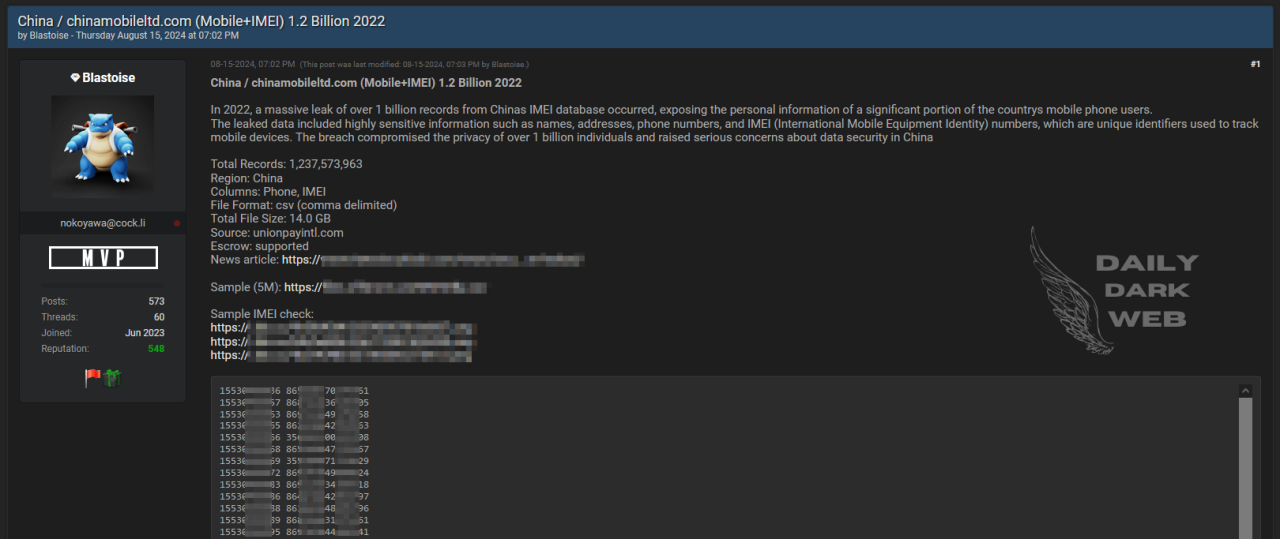
Three Mobile Exposes Critical Customer Details to Hackers
Three Mobile exposes critical customer details to hackers – a chilling headline that underscores a significant breach of trust and security. This incident highlights the vulnerabilities inherent in even established telecommunication companies and the devastating consequences for customers when their personal information falls into the wrong hands. We’ll delve into the specifics of the breach, examining the types of data compromised, the potential impact on affected individuals, and Three Mobile’s response to this crisis.
We’ll also explore the legal ramifications and discuss the steps both the company and its customers should take to prevent future incidents.
The scale of this data breach is truly alarming, impacting thousands of customers and raising serious questions about data security practices within the telecommunications industry. We’ll analyze the likely methods used by the hackers, the potential vulnerabilities exploited, and the long-term implications for Three Mobile’s reputation and customer confidence. This isn’t just a technical issue; it’s a story about the fragility of personal data in the digital age and the urgent need for robust security measures.
The Three Mobile Data Breach

The Three Mobile data breach, while thankfully addressed, serves as a stark reminder of the vulnerabilities inherent in even the most established telecommunications companies. The incident highlighted the critical need for robust security measures and the devastating consequences of data breaches for both the company and its customers. This breach wasn’t just about lost numbers; it exposed a significant amount of personal information, raising serious privacy concerns.The compromised data included a range of sensitive customer details.
Understanding the nature and scope of this breach is crucial for learning from past mistakes and preventing similar incidents in the future. The scale of the breach also underscores the importance of proactive security measures and the ongoing need for vigilance in protecting personal data.
Customer Data Exposed
The specific customer details exposed varied, but included names, addresses, phone numbers, and email addresses. In some cases, partial payment details were also compromised, though Three Mobile has consistently maintained that full payment card information was not accessed. The vulnerability exploited allowed hackers to access a database containing this information. The lack of strong encryption and potentially weak access controls likely contributed to the successful breach.
Methods of Access
While the precise methods used by the hackers haven’t been publicly disclosed in full detail to avoid assisting future attacks, it’s likely that the breach involved exploiting a vulnerability in Three Mobile’s systems. This could have ranged from a simple SQL injection attack to a more sophisticated phishing campaign targeting employees with access to sensitive data. The investigation into the breach likely focused on identifying the specific exploit and patching the vulnerability.
The use of malware to gain unauthorized access is another possibility, particularly if insider threat was involved.
Number of Affected Customers and Geographic Distribution
The exact number of affected customers varied across reports. Initial estimates suggested tens of thousands, while later reports suggested a potentially larger number, though a precise figure has never been officially confirmed by Three Mobile. The breach primarily affected customers within the United Kingdom, given that Three Mobile’s primary market is the UK. However, given the interconnected nature of global telecommunications, there’s a possibility some customers outside the UK might have also been affected, although the scale of such international impact remains unclear.
Summary of Compromised Data
| Data Type | Description | Severity | Potential Impact |
|---|---|---|---|
| Name | Full name of the customer | High | Identity theft, fraud |
| Address | Residential address | High | Physical harm, identity theft |
| Phone Number | Mobile phone number | Medium | Spam calls, phishing attempts |
| Email Address | Customer’s email address | Medium | Phishing attempts, spam emails |
Customer Impact

The Three Mobile data breach exposed sensitive personal information, leaving customers vulnerable to a range of serious risks. The consequences can be far-reaching and potentially devastating, impacting their financial security, personal identity, and overall sense of well-being. Understanding these potential impacts is crucial for affected individuals to take appropriate protective measures.The exposure of personal data in this breach presents significant risks to customers.
The leaked information could include names, addresses, phone numbers, email addresses, and potentially even financial details like bank account numbers or credit card information. This kind of comprehensive data set is a goldmine for cybercriminals looking to exploit vulnerabilities for financial gain or identity theft.
Potential Fraud and Identity Theft, Three mobile exposes critical customer details to hackers
With access to such detailed personal information, fraudsters can engage in a variety of illicit activities. This includes phishing scams, where customers might receive fraudulent emails or text messages appearing to be from legitimate organizations, prompting them to reveal further sensitive information or transfer funds. They could also be targeted for SIM swapping attacks, where criminals gain control of a customer’s mobile phone number to access online accounts and financial services.
Furthermore, the stolen data could be used to open fraudulent accounts in the customer’s name, leading to debt accumulation and damaged credit scores. Identity theft could range from relatively minor inconveniences, such as unsolicited mail, to severe consequences like loan applications or fraudulent tax returns filed in the victim’s name. In extreme cases, the ramifications can extend to legal battles and significant financial losses.
Steps to Protect Yourself
Following a data breach, proactive steps are vital to minimize potential harm. Customers should immediately review their bank and credit card statements for any unauthorized transactions. They should also consider placing a fraud alert or security freeze on their credit reports with all three major credit bureaus (Equifax, Experian, and TransUnion). This will make it harder for criminals to open new accounts in their name.
Furthermore, changing passwords for all online accounts, particularly those linked to financial institutions or sensitive personal information, is crucial. Using strong, unique passwords for each account significantly reduces the risk of account compromise. Monitoring accounts regularly for suspicious activity and reporting any unusual transactions promptly are essential steps in maintaining financial security. Finally, being vigilant about phishing attempts and only clicking on links from trusted sources is critical in preventing further compromise.
Resources for Mitigating Risks
It’s important for affected customers to access reliable information and support. The following resources can provide valuable assistance:
- Three Mobile’s Official Website: Check for official updates, FAQs, and support resources related to the data breach.
- Credit Reporting Agencies: Contact Equifax, Experian, and TransUnion to place a fraud alert or security freeze on your credit reports.
- Federal Trade Commission (FTC): The FTC website provides information on identity theft, fraud prevention, and reporting procedures.
- Your Bank and Credit Card Companies: Report any suspicious activity immediately to your financial institutions.
Legal and Regulatory Implications
The Three Mobile data breach raises significant legal and regulatory concerns, primarily revolving around the company’s responsibility to protect customer data under various data protection laws and its adherence to industry best practices following the breach. Failure to meet these standards can result in substantial financial penalties, reputational damage, and legal action from affected customers and regulatory bodies.The relevant data protection laws vary depending on the location of the affected customers, but the most pertinent legislation likely includes the UK’s UK GDPR (UK General Data Protection Regulation), which mirrors much of the EU’s GDPR.
This regulation mandates that organizations implement appropriate technical and organizational measures to ensure the security of personal data. Failure to do so can lead to significant fines, potentially reaching up to €20 million or 4% of annual global turnover, whichever is greater. Other relevant legislation might include the Data Protection Act 2018, which underpins the UK GDPR, and potentially sector-specific regulations depending on the nature of the compromised data.
Applicable Data Protection Laws and Regulations
The UK GDPR is central to this case. It Artikels the principles of data protection, including lawfulness, fairness, and transparency; purpose limitation; data minimisation; accuracy; storage limitation; integrity and confidentiality; and accountability. Three Mobile’s actions, or lack thereof, leading to the breach, will be assessed against these principles. A crucial aspect is demonstrating that appropriate technical and organisational measures were in place to protect the data.
Failure to meet this requirement forms the basis of potential legal action. The investigation will also examine whether Three Mobile notified the Information Commissioner’s Office (ICO) and affected individuals promptly and appropriately, as mandated by the GDPR.
Comparison to Industry Best Practices
Industry best practices for handling data breaches typically involve a multi-faceted approach. This includes proactive measures like robust security systems, regular security audits, employee training on data protection, and incident response plans. Following a breach, best practices dictate immediate containment of the breach, thorough investigation to determine the extent of the compromise, notification of affected individuals and relevant authorities, and remediation to prevent future incidents.
Comparing Three Mobile’s response to these best practices will be critical in determining liability. For instance, delays in notification or inadequate investigation could be viewed as negligence. A benchmark for comparison would be the response of other major telecommunication companies to similar breaches, examining their speed of response, transparency, and the measures taken to mitigate further damage.
Cases like the Yahoo! data breaches, which involved extensive delays in notification, serve as examples of what to avoid.
Potential Legal Actions Against Three Mobile
Several legal avenues are open to affected individuals and regulatory bodies. Individuals could pursue legal action for damages resulting from the breach, such as identity theft, financial loss, or emotional distress. Class-action lawsuits are a possibility, especially if a large number of individuals were affected. The ICO could also initiate enforcement action against Three Mobile, potentially leading to substantial fines for non-compliance with the UK GDPR.
Furthermore, Three Mobile could face legal challenges from regulatory bodies regarding its security practices and its response to the breach. The potential for legal action hinges on proving negligence or willful misconduct on the part of Three Mobile.
Financial and Reputational Consequences
The financial consequences for Three Mobile could be severe. This includes fines imposed by the ICO, legal costs associated with defending against lawsuits, and potential compensation payouts to affected individuals. The reputational damage could be equally significant, leading to a loss of customer trust and potentially impacting future business. The impact on share price is another significant consideration, with a potential for a substantial drop following the revelation of the breach and subsequent legal ramifications.
The long-term effects on customer acquisition and retention could also be substantial, requiring significant investment in rebuilding trust and improving security measures. The cost of implementing enhanced security measures following the breach would also add to the financial burden.
Technical Aspects of the Breach: Three Mobile Exposes Critical Customer Details To Hackers
The Three Mobile data breach highlights the critical need for robust cybersecurity measures in the telecommunications industry. Understanding the technical vulnerabilities exploited and the subsequent security improvements needed is crucial to preventing future incidents and protecting customer data. This section delves into the likely technical aspects of the breach, examining potential weaknesses and proposing preventative strategies.The hackers likely exploited a combination of vulnerabilities to gain access to Three Mobile’s systems and extract customer data.
One possibility is a SQL injection vulnerability. This occurs when malicious code is inserted into an input field on a website or application, allowing the attacker to manipulate the database queries and potentially extract sensitive information. Another potential vector is a compromised employee account, granting unauthorized access through phishing or credential stuffing attacks. Weak or default passwords, coupled with a lack of multi-factor authentication, could significantly increase the risk of this type of breach.
Furthermore, outdated or improperly configured software and servers could contain known vulnerabilities that hackers could exploit. Finally, the presence of unpatched systems creates an opening for attacks leveraging known exploits, leading to data exfiltration.
Vulnerabilities Exploited
Several vulnerabilities could have been exploited in the Three Mobile breach. These include SQL injection flaws in web applications, allowing attackers to directly query the database; insecure server configurations, potentially exposing sensitive data; and insufficient access controls, enabling unauthorized access to customer information. The use of weak passwords and the lack of multi-factor authentication also contributed significantly to the success of the attack.
Finally, the absence of regular security audits and penetration testing may have allowed vulnerabilities to remain undetected for extended periods.
Security Measures for Prevention
To prevent future breaches, Three Mobile should implement a multi-layered security approach. This includes regular security audits and penetration testing to identify and address vulnerabilities before they can be exploited. Strong password policies, coupled with mandatory multi-factor authentication, are crucial for limiting unauthorized access. Implementing robust intrusion detection and prevention systems can help detect and respond to malicious activity in real-time.
Regular software updates and patching are essential to mitigate known vulnerabilities. Finally, comprehensive employee security awareness training can help reduce the risk of phishing and social engineering attacks. Data encryption, both in transit and at rest, is also vital for protecting customer information even if a breach occurs.
Comparison with Competitors
Comparing Three Mobile’s security practices to its competitors requires access to detailed information about their respective security architectures and incident response plans, which is often confidential. However, based on publicly available information and industry best practices, it’s possible to make some general comparisons. Competitors that prioritize proactive security measures, such as regular penetration testing, vulnerability scanning, and robust incident response planning, are likely to be better positioned to prevent and mitigate data breaches.
Companies with a strong focus on employee security awareness training and multi-factor authentication also demonstrate a higher level of security maturity. Conversely, companies that rely solely on reactive measures or lack a comprehensive security strategy are more vulnerable to attacks.
Likely Attack Vector Diagram
The attack likely followed a path similar to this: The attacker first identified a vulnerability (e.g., a SQL injection flaw in a web application or a weak password on an employee account). This vulnerability served as the initial entry point into Three Mobile’s network. Once inside the network, the attacker moved laterally, potentially exploiting other vulnerabilities to gain access to sensitive customer data stored in databases.
The Three Mobile data breach, exposing sensitive customer info to hackers, highlights the urgent need for robust security in app development. This incident makes me think about secure development practices, and how platforms like those discussed in this article on domino app dev the low code and pro code future could help prevent such catastrophes. Ultimately, preventing future breaches requires a focus on secure coding from the outset, no matter the development approach.
Finally, the attacker exfiltrated the data, possibly using techniques like data transfer via compromised servers or using cloud storage services. This entire process could have been facilitated by insufficient monitoring and a lack of robust intrusion detection systems. The diagram would visually represent this sequence: External Network -> Vulnerability (e.g., SQL injection, weak password) -> Internal Network -> Lateral Movement -> Database containing customer data -> Data Exfiltration -> Attacker.
This illustrates the progression from initial compromise to data exfiltration, highlighting the various stages and potential points of failure within Three Mobile’s security infrastructure.
Long-Term Effects
The Three Mobile data breach, while seemingly contained in the immediate aftermath, casts a long shadow with potentially devastating long-term consequences for the company, its customers, and the wider telecommunications industry. The erosion of trust, the potential for ongoing financial losses, and the ripple effects on future regulations are all significant concerns. Understanding these long-term impacts is crucial for both Three Mobile and its competitors, to prevent similar incidents and to navigate the evolving landscape of data security.The immediate impact of a data breach is often the most visible, but the lingering effects can be far more damaging and difficult to quantify.
Loss of customer trust, for example, can translate into lost revenue, reduced market share, and a diminished brand reputation that takes years to rebuild, if ever. This isn’t simply about losing existing customers; it also impacts the acquisition of new ones, as potential customers will be wary of entrusting their personal data to a company with a history of security failures.
Reputation and Customer Trust
The damage to Three Mobile’s reputation will likely be significant and prolonged. Customers who had their data compromised may feel violated and distrustful, leading them to switch providers. This loss of customer loyalty can have a significant financial impact, potentially lasting for several years. The company will need to invest heavily in rebuilding trust, through transparent communication, enhanced security measures, and proactive customer support.
Failure to do so could result in a long-term decline in market share and profitability. The Equifax breach of 2017, for example, resulted in years of legal battles, reputational damage, and a significant drop in stock value, illustrating the enduring consequences of a major data breach.
Influence on Future Data Protection Policies and Regulations
This breach will likely contribute to stricter data protection policies and regulations within the UK and potentially globally. Regulatory bodies will scrutinize Three Mobile’s security practices and may impose significant fines or other penalties. This incident could also accelerate the adoption of more robust data security standards across the telecommunications industry, driving the need for increased investment in security infrastructure and employee training.
The General Data Protection Regulation (GDPR) in Europe already sets a high bar for data protection, and events like the Three Mobile breach underscore the need for continuous improvement and stricter enforcement. We might see further legislation requiring more stringent data encryption, more rigorous security audits, and greater transparency regarding data handling practices.
Recommendations for Improving Data Security Practices
Improving data security in the telecommunications industry requires a multi-pronged approach. This includes investing in advanced security technologies such as robust encryption, intrusion detection systems, and multi-factor authentication. Furthermore, regular security audits and penetration testing are crucial to identify vulnerabilities before they can be exploited. Employee training programs focused on cybersecurity awareness and best practices are also essential.
A culture of security must be fostered, where data protection is a top priority at all levels of the organization. Finally, robust incident response plans are needed to minimize the impact of future breaches and ensure swift and effective remediation. The lessons learned from this breach should serve as a catalyst for industry-wide improvements, leading to a more secure and resilient telecommunications ecosystem.
Outcome Summary

The Three Mobile data breach serves as a stark reminder of the ever-present threat of cyberattacks and the critical importance of robust data security practices. While Three Mobile has taken steps to mitigate the damage and inform affected customers, the long-term consequences of this breach will undoubtedly impact its reputation and customer trust. The incident also underscores the need for stronger regulations and industry-wide improvements in data protection to prevent similar breaches in the future.
The lessons learned here should prompt a critical review of security protocols across the telecommunications sector and beyond, emphasizing proactive measures to safeguard sensitive personal information.
Q&A
What types of data were compromised in the Three Mobile breach?
Reports suggest a range of sensitive data was exposed, potentially including names, addresses, phone numbers, email addresses, and potentially financial information. The exact extent is still under investigation.
What should Three Mobile customers do to protect themselves?
Customers should monitor their bank accounts and credit reports closely for any suspicious activity. They should also be wary of phishing attempts and report any unusual emails or calls. Consider activating fraud alerts with your bank and credit card companies.
Will Three Mobile face legal repercussions?
Depending on the investigation’s findings and the extent of the damage, Three Mobile could face significant fines and legal action under various data protection laws, including potential class-action lawsuits from affected customers.
How can Three Mobile prevent future breaches?
Investing in advanced security technologies, implementing robust employee training programs on cybersecurity best practices, and conducting regular security audits are crucial steps. They also need to enhance their vulnerability management program and improve incident response capabilities.





